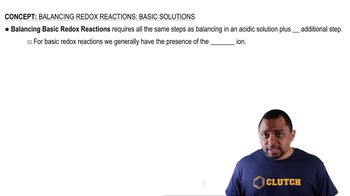Here are the essential concepts you must grasp in order to answer the question correctly.
Net Ionic Equations
Net ionic equations represent the actual chemical species that participate in a reaction, excluding spectator ions. They are derived from complete ionic equations by removing ions that do not change during the reaction. This simplification helps to focus on the essential chemical changes occurring in the solution.
Recommended video:
Basic Solution
A basic solution has a pH greater than 7 and contains hydroxide ions (OH-). In such solutions, certain reactions may involve the addition of hydroxide ions to neutralize acids or to form precipitates. Understanding how to manipulate the presence of OH- is crucial for balancing reactions in basic conditions.
Recommended video:
Balancing Basic Redox Reactions
Balancing Chemical Equations
Balancing chemical equations involves ensuring that the number of atoms for each element is the same on both sides of the equation. This is essential for obeying the law of conservation of mass. In the context of net ionic equations, balancing also includes accounting for charge, ensuring that the total charge is equal on both sides.
Recommended video:
Balancing Chemical Equations
 Verified step by step guidance
Verified step by step guidance


